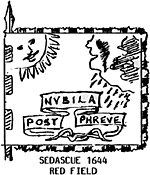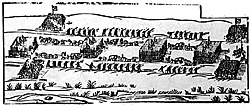 Born in Germany the son of a Lord, George Sedascue was brought up during the turmoil of the Thirty Years War. Perhaps having seen service in Europe, Sedascue fled to England in 1640, but for what reason is uncertain. A small number of German refugees appear to have arrived in England at this time, and when the English Civil War broke out in the Spring 1642, most of these young men sought service in the rapidly raised regiments of both sides.
Born in Germany the son of a Lord, George Sedascue was brought up during the turmoil of the Thirty Years War. Perhaps having seen service in Europe, Sedascue fled to England in 1640, but for what reason is uncertain. A small number of German refugees appear to have arrived in England at this time, and when the English Civil War broke out in the Spring 1642, most of these young men sought service in the rapidly raised regiments of both sides.
Being of the Protestant faith and numbered among the nonconformists, George Sedascue joined the Army of Parliment, and being a gentleman of some quality, was appointed Cornet to Major John Urry's troop by August 1642, serving that same year at the siege of Portsmouth.
On 10 March 1644, Sedascue was to be found as Major to Sir Michael Livesey's Kentish Horse, which joined the Northern Army of Sir William Waller. During that year Sedascue fought at Cheriton, Cropredy Bridge and Second Newbury. Because of the hard usage made of Livesey's Regiment, it had mutinied after Cropredy, returning to its native Kent, but there is no evidence that Sedascue followed it.
When Waller's command was disbanded in 1645, Livesey's men were included in those Regiments for the New Model Army. Sir Michael Liveaey however was removed as Colonol and the Regiment given to Henry Ireton, with George Sedascue once more as its Major.
 On the eve of the Battle of Naseby, Ireton's Regiment beat up the
Royalist headquarters in Naseby village and took a number of prisoners. At Naseby itself
the Regiment was at first broken by Prince Rupert's charge, but later did good service.
Sedascue was that year present at the siege of Bristol, and the last campaign against
Ralph Hopton's forces around Exeter, before taking part in the siege of Oxford in 1646.
On the eve of the Battle of Naseby, Ireton's Regiment beat up the
Royalist headquarters in Naseby village and took a number of prisoners. At Naseby itself
the Regiment was at first broken by Prince Rupert's charge, but later did good service.
Sedascue was that year present at the siege of Bristol, and the last campaign against
Ralph Hopton's forces around Exeter, before taking part in the siege of Oxford in 1646.
When in March 1647, the Crisis in the Arny broke out over pay and the plan to send certain Regiments to Ireland, Major Sedascue was among those of Henry Ireton's Regiment who petitioned the Parliament on 16 May. But being now a professional soldier, George Sedascue sided with Parliament and accepted Irish Service. Because of this Sedascue lost his commission under Ireton.
Nevertheless, George Sedascue was too good a soldier to bar fron service, and in Ortober 1648 was appointed as Agitant-Generall of Horse.
In his late career, during the argument between the Army led by Charlens Fleetwood and John Lambert and the so-called 'Rump' of the Long Parliament in 1659, George Sedascue again sided with Parliament and was removed from office. But following the declaration at Portsmouth by Sir Arthur Haslerig and the pro-Rump members of the Army, Fleetwood backed down and Parliament was returned. In the purge of the Army which followed, George Sedascue was appointed Major to Colonel Unton Croke.
It was now but a few short steps to the Restoration of Charles II. In the total reorganisation of the Army following the Restoration, George Sedascue was once more removed and retired to civilian life.
George Sedascue lived a further twenty-eight years, dying just after the Glorious Revolution of 1688, at his house Heath Hall, and was buried at Normanton on 4 December.
POSTSCRIPT
It is interesting to note that in his book on Cheriton 1644, Dr.Adair mentions that Livesey's Regiment was said to have had Blue 'facings' to their Red Coats. There could be a simple explanation for this if the reference takes into account that Livesey was to be Colonel of it in the New Model, and the order was actually for Red Coats lined B1ue. This would of course suggest the Regiment of Colone1 Henry Ireton had Blue linings to its coats.
REFERENCES
The Nonconformist Register - Heywood and Dickenson (1881) p.73
Cheriton 1644: The Campaign and the Battle, Dr. John Adnir p. 176-7 (Roundwood P.)
The Clarke Papers, ed. C.H. Firth 4 Vols. (Camden Society).
The unpublished notes of Benton on Parliamentarian section WA/5
Related
Back to English Civil War Notes&Queries No. 1 Table of Contents
Back to English Civil War Times List of Issues
Back to Master Magazine List
© Copyright 1984 by Partizan Press
This article appears in MagWeb (Magazine Web) on the Internet World Wide Web.
Other military history articles and gaming articles are available at http://www.magweb.com